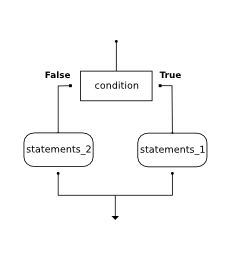7.4. Conditional Execution: Binary Selection¶
In order to write useful programs, we almost always need the ability to check conditions and change the behavior of the program accordingly. Selection statements, sometimes also referred to as conditional statements, give us this ability. The simplest form of selection is the if statement. This is sometimes referred to as binary selection since there are two possible paths of execution.
The syntax for an if statement looks like this:
if BOOLEAN EXPRESSION:
STATEMENTS_1 # executed if condition evaluates to True
else:
STATEMENTS_2 # executed if condition evaluates to False
The boolean expression after the if statement is called the condition.
If it is true, then the immediately following indented statements get executed. If not, then the statements
indented under the else clause get executed.
As with the function definition from the last chapter and other compound
statements like for, the if statement consists of a header line and a body. The header
line begins with the keyword if followed by a boolean expression and ends with
a colon (:).
The more indented statements that follow are called a block.
Each of the statements inside the first block of statements is executed in order if the boolean
expression evaluates to True. The entire first block of statements
is skipped if the boolean expression evaluates to False, and instead
all the statements under the else clause are executed.
There is no limit on the number of statements that can appear under the two clauses of an
if statement, but there has to be at least one statement in each block.
Each compound statement includes a heading and all the following further-indented statements in
the block after the heading. The if - else statement is an unusual compound statement because it
has more than one part at the same level of indentation as the if heading,
(the else clause, with its own indented block).
Lab
Approximating Pi with Simulation In this guided lab exercise we will work through a problem solving exercise related to approximating the value of pi using random numbers.
Check your understanding
- Just one.
- Each block may also contain more than one.
- Zero or more.
- Each block must contain at least one statement.
- One or more.
- Yes, a block must contain at least one statement and can have many statements.
- One or more, and each must contain the same number.
- The blocks may contain different numbers of statements.
select-4-3: How many statements can appear in each block (the if and the else) in a conditional statement?
- TRUE
- TRUE is printed by the if-block, which only executes if the conditional (in this case, 4+5 == 10) is true. In this case 5+4 is not equal to 10.
- FALSE
- Since 4+5==10 evaluates to False, Python will skip over the if block and execute the statement in the else block.
- TRUE on one line and FALSE on the next
- Python would never print both TRUE and FALSE because it will only execute one of the if-block or the else-block, but not both.
- Nothing will be printed
- Python will always execute either the if-block (if the condition is true) or the else-block (if the condition is false). It would never skip over both blocks.
select-4-4: What does the following code print (choose from output a, b, c or nothing)?
if 4 + 5 == 10:
print("TRUE")
else:
print("FALSE")
- Output a
- Although TRUE is printed after the if-else statement completes, both blocks within the if-else statement print something too. In this case, Python would have had to have skipped both blocks in the if-else statement, which it never would do.
- Output b
- Because there is a TRUE printed after the if-else statement ends, Python will always print TRUE as the last statement.
- Output c
- Python will print FALSE from within the else-block (because 5+4 does not equal 10), and then print TRUE after the if-else statement completes.
- Output d
- To print these three lines, Python would have to execute both blocks in the if-else statement, which it can never do.
select-4-5: What does the following code print?
if 4 + 5 == 10:
print("TRUE")
else:
print("FALSE")
print("TRUE")
a. TRUE
b.
TRUE
FALSE
c.
FALSE
TRUE
d.
TRUE
FALSE
TRUE
